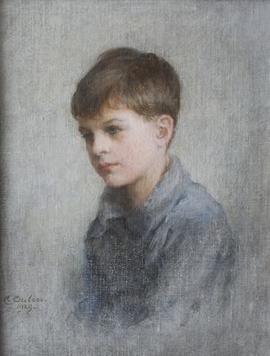Casper, Alexander Carl Peter, 1923-1944
- GB-2014-WSA-04561
- Person
- 1923-1944
Casper, Alexander Carl Peter, son of Lieut.-Col. Emil Hans Casper and Una Margaret, d. of Sir Edward Parrott MP LLD, of Edinburgh; b. 23 Aug. 1923; adm. Jan. 1937 (A); left Apr. 1941; RM 1942-5 (Lieut.), 45th Commandos BLA; killed in action at the crossing of the Weser 6 Apr. 1945. Castellain, Geoffrey Charles, son of E. L. F. and Anne Castellain of Chelsea; b. 19 Feb. 1920; adm. Sept. 1933 (KS); left July 1938; Ch. Ch. Oxf., matric. 1938; 2nd Lieut. 16th/5th Lancers 1941, transf. SASR Apr. 1944; killed in action (W. Europe) Oct. 1944.
Alexander Carl Peter Casper was born on the 23rd of August 1923 the son of Lieutenant Colonel Emil Hans “Bill” Casper, Royal Artillery, and Una Margaret (nee Parrott) Casper of 11, Acacia Grove, Dulwich, London SE21. He was educated at Westminster School where he was up Ashburnham from January 1937 to April 1941.
On leaving school he was commissioned in the Royal Marines and was posted to No. 45 Royal Marine Commando.
At 4.30am on the morning of the 6th of April 1945, No. 45 Commando assembled at Stolzenau where they were briefed for an assault crossing of the River Weser where they were to pass through a weakly held bridgehead on the far side of the river and were to push on to capture the village of Leese, one and half miles inland. Once they were across the river a bridge was to be constructed across it to allow more British forces to cross the river. At 1.15pm, nine assault landing craft began crossing the river supported by artillery and machine gun fire. Although the landing craft were under continuous enemy fire during the crossing they suffered no casualties. Once they had landed on the far side the Commandos advanced south along the river bank under the cover of its steep banks. The German positions, which were held by the 12th SS Training Battalion, were set back some one hundred yards from the river bank across open ground which made it impossible to make a direct attack on them. After hand to hand fighting the men of D Troop gained a foothold in the enemy trenches nearest to the river after which A Troop passed through them and pressed on against “fanatical” opposition. At the same time, B Troop, with a Section of E Troop, made their way towards the cover of a nearby railway embankment but, by 4pm, the bulk of the Commandos were still pinned down and forward progress was painfully slow. It was decided to recall the men of B and E Troops from their forward position and to consolidate the positions on the river bank to await reinforcements. They came under heavy fire through the evening and into the night when they were told that there would be no fresh troops coming forward to support them. After midnight they received orders to fall back to the bridgehead area but while they were doing this they came under an attack from the SS at 3am which they drove off with heavy casualties among the enemy. They held the bridgehead for the remainder of the 7th of April.
Captain John Day of No. 45 Commando later wrote: - "At one of our brief pauses as we moved along the river bank I found myself crouching beside a young subaltern, Peter Casper, whose men were endeavouring to provide us with some covering fire. During a lull in the firing we heard shouting from the German positions. Peter said "They want to surrender", leapt to his feet, took off his beret, and waved it at the enemy. Two or three bullets cracked at us and Peter Casper fell dead at my feet."
He is buried at Hanover War Cemetery Plot 7, Row K Grave 7.

